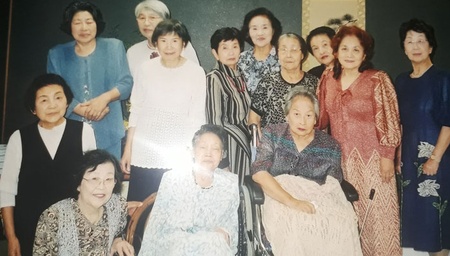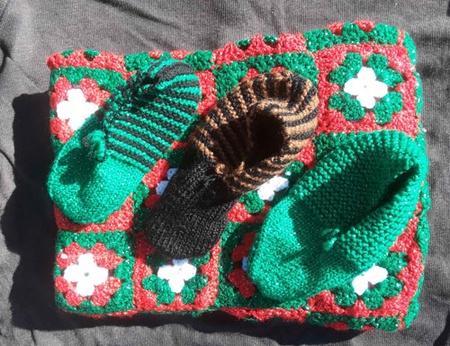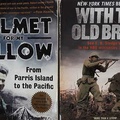Kiyoko Terao interrupted her career as a Tokyo seamstress to come to Seattle, temporarily in 1959, to help her older sister care for her four children. While here, a Nisei asked her to marry him, and so she ended up staying. Below, Kiyoko shares her life story, beginning with her days as a high school student in Imabari, Ehime-ken, Shikoku, during World War II, continuing with her Seattle career, and ending with her present-day life.
* * * * *
Among the most charming people whose voices, and occasionally, faces I come across these days is that of my friend, Kiyoko Terao. If it has been a while since I have seen her, I call her up. Her always cheery voice uplifts my weeks. She also gives me someone to talk to at length in Japanese. For while my NAP workmates are all Japanese expatriates, we hold 95% of our work conversations in English. My kitchen Japanese is insufficient for project management and my workmates need to be sure that I “get it.”
One of the things I like about Kiyoko is that she is always happy to receive, and make use of, modest things that others will not. A bucket of purple plums? She will make jam. Bread from the Franz outlet store near the Japanese Cultural and Community Center (jcccw.org)? She will make toast and sandwiches. Yarn and fabric found by Sansei friends cleaning up parental homes? She will make hats, blankets, bootees, and aprons to give back to us.
Yet, like many an elder, unless pressed, Kiyoko seldom talks about herself. In late 2020, I began asking her such probing questions, for I would kick myself later if I didn’t start doing so in the quiet of a pandemic winter. Better understanding the life experiences of older people around us helps us to place our own small lives in perspective.
Kiyoko is from Imabari, Ehime prefecture, Shikoku, Japan. She first came to the Seattle, temporarily, to help her older sister care for her four children. While here, a Nisei, Masashi “Masu” Terao, asked for Kiyoko’s hand in marriage. And so she ended up staying.
Kiyoko has many Sansei friends from the social dance class many of us participated in at the Nisei Veterans Hall, before the COVID-19 pandemic abruptly ended it in February 2020. She came to that class because she wanted to pick up dance classes where she had left off, when it had been her only fun, in burned-out Imabari, after World War II.

Imabari had the misfortune to be firebombed on the night of August 5-6, 1945, hours before the atomic bombing of Hiroshima (Aug. 6). It was only days before Japan’s surrender. The government telegrammed its intent to surrender to the Allied Powers on Aug. 10.
The following is a summary of multiple conversations over the past few months, translated from Japanese.
What was your life like before and during World War II?
I was a high school student at Seika Kouto Jougakkou, a girl’s high school (that is still in existence). My father saw to it that all of his nine kids got at least a high school education. (At the time in Japan, high school was not compulsory, as parents had to pay tuition.) I was the seventh child.
Owing to the war, my classmates and I did things like help bring in the autumn rice harvest, as all the men were away at war. We had never done this before.
During the school year, I studied in the closet to not let light escape during the nightly blackouts. While the first year of war was “okay,” across the next three, it gradually became worse—“taihen”—a serious matter.
What kind of work did your parents do?
My father had a business embroidering “mon,” family crests, onto kimonos. It was a “good business.” He drew the mons; then the women in the family would sew them on.
What was the night of the bombing like?
I was taking shelter in a cave in the mountains. My father stayed at home alone to keep an eye on the house. He tried to put out the fires that ensued from the incendiary bombs, but after he realized he could not, he just ran.
That night, eighty percent of the houses in Imabari burned to the ground, including ours. We were made homeless in one night!
What were the ensuing days and weeks like?
We slept on the beach the first night where there were many mosquitoes. After that, the family temporarily took shelter in a nearby country school. However, as many families were doing so, it was hard to sleep. At all hours of the night, children were crying, etc.
We stayed at the school for a month, after which we had to vacate, so the school could reopen. In Japan, summer vacation is only one month long, in August.
From the next month, my father was able to rent space in a sento, a public bathhouse which did not burn because it was made of concrete. There, we slept on the tile floor.
How did you eat?
As we could, we returned to our home to retrieve belongings that would sustain us. We had kimonos in our yard bomb-shelter which my older brother, who had returned home from the war, had dug.
We brought the kimonos to the country, to trade them for vegetables from the farmers. At the time, the farmers did not want money. They wanted clothes. Still, I remember I was “always hungry.”
Moreover, my family lived without light for years. We had candles and cooking oil which we burned by setting string wicks in dishes of the oil.
We would look into the windows of those with surviving homes with envy.
Did you see the atomic bombing of Hiroshima?
No, the distance is too far. But after the Hiroshima bombing, small boats with wounded people began arriving in Imabari seeking help.
Did your parents eventually rebuild their house?
Well, at first, they built something like barracks. Here, it is important to understand that it was not like disasters in Japan now, such as after the 2011 Tohoku earthquake, where the government is helping cities and people recover.
After WWII, Japan had lost the war. No help at all was forthcoming.
So it was “gaman gaman,” Kiyoko says, using the word for perseverance twice for emphasis.
After war’s end, what did you do next?
I furthered my education by attending a sewing school, Matsuyama Dressmaker Jougakuin (also rebuilt after war) for two years. It was in Matsuyama, which took an hour and a half to get to and from, each way. There, I obtained the equivalent of an associate’s degree in sewing.
By the late 1950s, I had my own career working in Tokyo. I did not plan nor want to come to the US. But my sister would not stop asking for my help. So, it was set up for me to come on a student visa to “learn sewing.”
I arrived the day before Thanksgiving in 1959.
After marrying, what kind of work did you do here?
I worked for 25 years at Lighthouse for the Blind. We sewed ties for US military uniforms. The ties were shipped out in bundles of 48.
We also made signal flags for navy ships and the like. It was mostly military contract work.
Can you guess how long it took me to make a bundle of 48 ties? I made 48 ties in 15 minutes!
I was one of the three fastest people there. In addition to making the ties fast, I liked to make them well.
My supervisor used to say, “Kiyoko, you don’t have to make them so well.”
It was piece-work. We were paid by the bundle.
I also used to teach Nisei women how to sew in my home.
What are your thoughts on the current pandemic?
I like to keep busy. I go on walks with my Chinese friend, who is an excellent cook, who always brings me “leftovers.”
I have a roof over my head and plenty to eat.
When I am watching TV, I don’t like to just sit. I am always making something.
Soon, there will be work to do in the yard.
Americans waste food.
Do you dream about Japan at night?
(The question is based on the experience of Arisa Nakamura, a more recent immigrant; see “Shin-Issei Journey,” arisan-artworks.com, episode 30).
Yes. I don’t dream about my husband. (Kiyoko laughs!) I envision my long-ago classmates. We continued to get together across our lives, but we no longer do so.
* * * * *
In examining Kiyoko’s life, what becomes obvious is that she was not a war bride, a person who married a US soldier in Occupied Japan or Germany, in some cases to survive. Instead, in the widely reported sequence of Japanese immigration and acculturation to these shores (Issei, Kibei, war brides), she was at the leading edge of the next group, the Shin-Issei. These are the postwar new immigrants who came for their own, varied, individual reasons. Most arrived after the Immigration and Nationality Act of 1965 removed barriers to non-white immigration that had been in place since 1924. The wave that people like Kiyoko began continues to the present day.
*This article was originally published in The North American Post on April 25, 2021.
© 2021 David Yamaguchi / The North American Post










